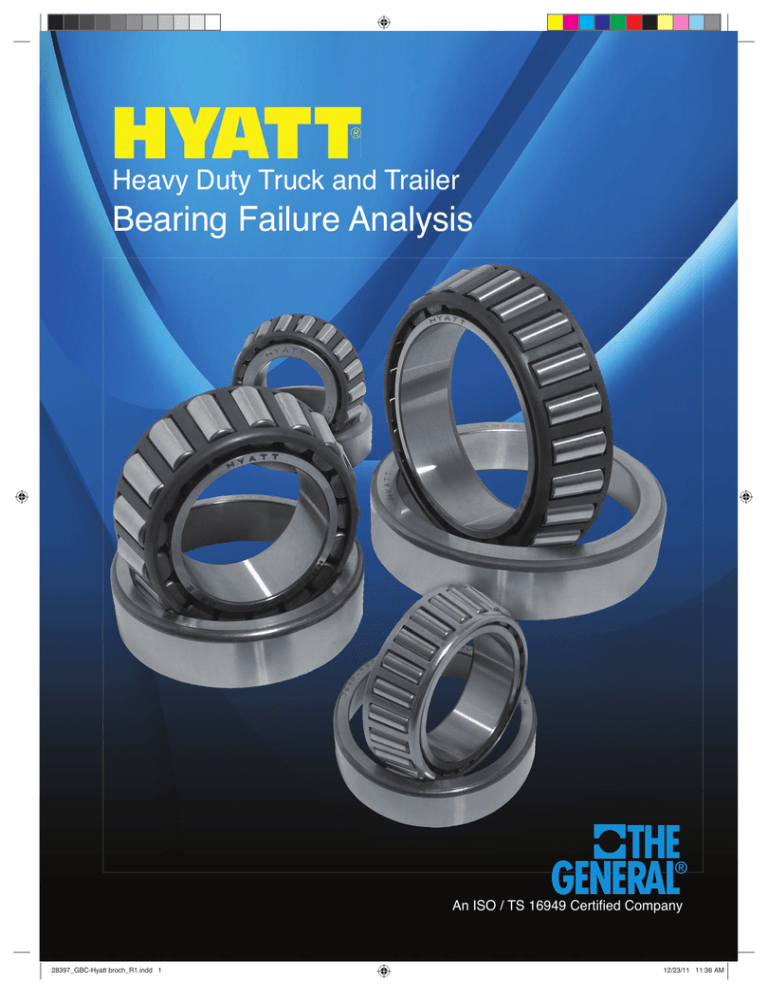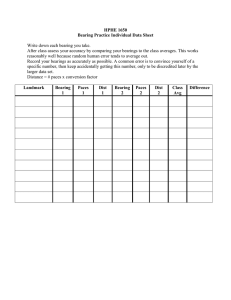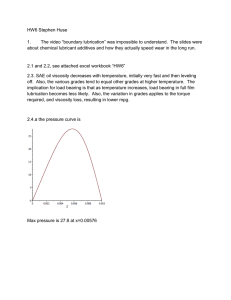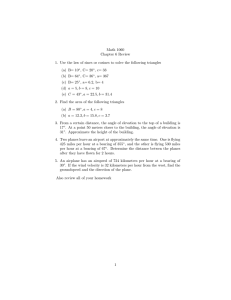Bearing Failure Analysis - General Bearing Corporation
advertisement

Heavy Duty Truck and Trailer Bearing Failure Analysis An ISO / TS 16949 Certified Company 28397_GBC-Hyatt broch_R1.indd 1 12/23/11 11:36 AM Company Overview General Bearing Corporation (GBC) occupies a unique position in the bearing industry. Renowned for its ability to combine quality with competitive cost structures, GBC’s winning combination has been used to establish a first class reputation at Original Equipment Manufacturers as well as the Aftermarket. With engineering, sales, and logistics located in New York, and stateof-the-art manufacturing facilities in China, General Bearing is an ISO/TS 16949 certified manufacturer General Bearing Corporation Headquarters West Nyack, NY of ball and roller bearings. Under our brands HYATT and THE GENERAL, OEMs and distributors around the world rely on General Bearing Corporation for consistent, high quality products and service. Industries currently using General Bearing products include: • Heavy Trucks • Truck Trailers • Automotive • Electric Motors • Industrial Equipment • Lawn & Garden • Material Handling • Office Equipment • Power Tools • Railroad • Recreational Vehicles 28397_GBC-Hyatt broch_R1.indd 2 12/23/11 11:36 AM Index Introduction Introduction --------------------------------------------------------------------------------------------------------------------------------------- 3 Prior to Installation ------------------------------------------------------------------------------------------------------------------------- 4 Correct Bearing Installation Techniques ---------------------------------------------------------------------------------- 4 Failure Modes Grooving --------------------------------------------------------------------------------------------------------------------------------------------- 5 Pitting and Contaminants ------------------------------------------------------------------------------------------------------------- 5 Excessive Abrasive Wear -------------------------------------------------------------------------------------------------------------- 6 Etching from Moisture Contamination -------------------------------------------------------------------------------------- 6 Friction Corrosion ---------------------------------------------------------------------------------------------------------------------------- 6 Operating Conditions Misalignment ------------------------------------------------------------------------------------------------------------------------------------- 7 Static Overload ---------------------------------------------------------------------------------------------------------------------------------- 7 Outer Diameter Damage ----------------------------------------------------------------------------------------------------------------- 8 Effects of Lubrication Starvation -------------------------------------------------------------------------------------------------- 8 Effects of Electrical Current ----------------------------------------------------------------------------------------------------------- 8 Fracture ------------------------------------------------------------------------------------------------------------------------------------------------ 8 Failure Analysis Failure Modes -------------------------------------------------------------------------------------------------------------------------------------- 10-13 28397_GBC-Hyatt broch_R1.indd 3 12/23/11 11:36 AM Introduction The size of a bearing has no affect on its resistance to improper operating conditions, poor handling, or environmental influences. Bearings are precision components. Their manufacturing tolerances are often not found in other components that are part of the same assembly. Modern machining techniques and processes have managed to keep the cost of bearings low, masking their value as highly precise machine elements. It is a known statistical fact that greater than 90% of all bearing failures are due to external influences. These include lubrication conditions, assembly installation techniques, contamination of the operating environment, and improper bearing size selection for the application. Under proper operating conditions, a bearing should only fail from fatigue which is predictable based on the bearing size and it’s application parameters. Many other types of bearing damage prevented with the g can be p knowledge of how external influences affect the life of a rolling bearing. g. For that reason, we present this his guide as a reference towards understanding the causes and effects of bearing damage. e. 3 28397_GBC-Hyatt broch_R1.indd 4 12/23/11 11:36 AM Prior to Installation Bearings should be stored in a clean and dry location without exposure to vibration. Handle bearings with care. A drop from even a low height or a low shock load can cause rolling surface brinelling, a starting point for surface damage. Keep bearings in their original packaging until they are installed. Avoid cleaning or degreasing a new bearing as it will remove the preventative rust coating. Hands should be clean and dry. Gloves are recommended. The work area should be clean with minimal exposure to contaminant generating equipment. Never spin a bearing with compressed air. Correct Bearing Installation Techniques Use only the lubricant chosen for the application during installation. Do not mix lubricants. Use the appropriate sized tools for the bearing. Check for tool wear often. Assure that both the shaft and housing seating areas are clean and free from contaminants. The dimensions of the shaft and housing as well as any radii contacting the bearing should be confirmed as correct for the bearing size chosen. Avoid touching bearing surfaces with bare hands as this can lead to surface oxidation. Prior to press fitting, assure the bearing is aligned. Only apply force to the bearing race being pressed. For example: Do not cross load the bearing by pressing on the inner race when the outer race is being fitted. Do not apply shock loads to the bearing during assembly either through mishandling or direct use of a hammer. 4 28397_GBC-Hyatt broch_R1.indd 5 12/23/11 11:36 AM Failure Modes Grooving Grooving occurs when hard contaminants enter the bearing and get wedged in the cage and cut grooves in the rollers. Particles can also get caught between rollers and cut grooves in the bearing races. The damage is permanent and will lead to early bearing failure. Pitting and Contaminants Pitting is damage that is also caused by foreign material such as dirt or metal particles entering the bearing. The most likely source of these particles are improperly cleaned housings. Even light pitting may lead to eventual bearing failure. Caution should be taken to evaluate whether lightly damaged parts should be returned to service. Excessive contaminants and resulting raceway pitting. 5 28397_GBC-Hyatt broch_R1.indd 6 12/23/11 11:36 AM Excessive Abrasive Wear from Contaminants Extremely contaminated environments will cause excessive wear to the point of wearing down roller ends as shown here. Bearing life is severely reduced in this situation. Abrasive wear occurs when a hard rough surface slides across a softer surface. Damage caused by lubricant-borne particles in rolling/sliding contacts can severely reduce the operational life of ball and roller bearings. Lubricant supplies frequently contain such contaminating particles, either generated from within the machinery itself or incorporated into the fluid from the surroundings. Etching from Moisture Contamination When water is allowed to enter the bearing assembly and mix with the system lubricants, a chemical reaction can cause surface etching as shown above. Frictional Corrosion Small vibrations will cause the bearing rolling pathway surfaces to rub together when the bearing is not rotating, such as when an assembly with installed bearings are shipped. The rubbing eventually leads to surface oxidation and a failure initiation point. Properly installed bearings with correct clearance and lubrication can alleviate this. 6 28397_GBC-Hyatt broch_R1.indd 7 12/23/11 11:36 AM Operating Conditions Misalignment Misalignment caused by installtation forces the centerline of the inner bearing race (cone) to operate at a slight angle to the centerline of the outer race (cup). This causes the load to be unevenly distributed creating greater than expected stress at one end of the rolling surfaces. Eventually, this will lead to surface spalling and premature failure as shown. The unexpected forces caused by misalignment can extend outside of the bearing, influencing the bearing mating components and causing other unexpected and uneven wear. In the photos shown here, a misalignment condition has caused wear between the cone bore and shaft outer diameter and caused the bore to have a polished appearance. Static Overload Static overload of a stationary bearing from either load or shock will produce true brinelling or permanent plastic deformation at the rolling element and raceway contact points. Excessive preload, improper installation, or improper handling can all cause this condition. This will lead to premature failure. 7 28397_GBC-Hyatt broch_R1.indd 8 12/23/11 11:36 AM Outer Diameter Damage In these photos, grooves and heavy wear on the outer diameter of the cup indicate that the cup was spinning inside the housing/hub. This condition is most often caused by improper fits or misalignment. Effects of Lubrication Starvation Lack of lubrication in fully loaded bearings will cause prompt and severe failure. Improper maintenance, installation, and poor sealing are several root causes. In addition to the destruction of the roller separator pictured above, overheating due to high friction will affect all bearing components. 8 28397_GBC-Hyatt broch_R1.indd 9 12/23/11 11:36 AM Effects of Electrical Current Due to small internal clearances in the bearing, electrical current can arc between component surfaces causing rolling surface pitting. This will eventually lead to failure. Proper grounding techniques should be employed to avoid current passing through bearings. Fracture Excessive preload, high shock loads, poor handling and extreme thermal conditions can lead to component fracture. 9 28397_GBC-Hyatt broch_R1.indd 10 12/23/11 11:36 AM Failure Analysis Failure Modes ISO 15242:2004(E) is a comprehensive document on Bearing Failure Analysis. Almost all bearing failure modes can be classified into one of these six categories: Fatigue Wear Corrosion Plastic Deformation Fracture Electrical Erosion Failure Causes Almost all bearing failure causes can be classified into one of these five categories: Lubricant Mounting Application Design Handling Operating Condition 10 28397_GBC-Hyatt broch_R1.indd 11 12/23/11 11:36 AM Lubricant Based Failure Causes All bearings need proper lubrication to function properly. Lubrication must be correctly selected, be applied to the correct quantity level, be clean, monitored, and maintained correctly. Insufficient Lubricant Incorrect Viscosity Inadequate Quality Contamination 3 3 3 3 3 3 Material Smearing 3 3 3 Scratches 3 3 3 3 3 3 3 3 3 3 3 3 3 Increased Wear Excessive Lubricant Tracks Scores Hot Running Pitting Spalling 3 Rust Cage Fracture 3 3 3 3 3 3 Indentations Thermal Cracks 3 3 3 Operating Condition Based Failure Causes Operating conditions must be carefully considered when choosing the proper bearing and determining the bearing’s expected life. Increased Wear Excessive Speed Excessive Load Frequently Fluctuating Loads 3 3 3 3 3 3 3 3 3 Scores Material Smearing Vibration 3 Fluting 3 Chatter Marks Hot Running Pitting Spalling 3 3 3 3 3 3 3 3 Fretting (Rust) 3 Fracture Cracks Cage Fracture Indentations Thermal Cracks Passage of Electrical Current 3 3 3 3 3 3 3 3 3 3 3 11 28397_GBC-Hyatt broch_R1.indd 12 12/23/11 11:36 AM Bearing Mounting Based Failure Causes Incorrect mounting practices can severely shorten bearing life. Faulty Electrical Insulation Incorrect Mounting Incorrect Heating Misalignment 3 3 3 3 3 3 3 3 Increased Wear Scratches Fluting Hot Running Pitting Spalling Electrical Craters 3 3 3 3 3 3 3 3 3 Fracture Cracks Cage Fracture Deformation Indentations 3 3 Thermal Cracks Increased Wear Tracks Undesirable preload Impact Inadequate fixing Uneven seating Surface Incorrect Seating fit 3 3 3 3 3 3 3 3 3 3 3 Smearing Hot Running Pitting Spalling 3 3 3 3 3 Fretting (rust) Fracture Cracks Cage Fracture Deformation Thermal Cracks 3 3 3 3 3 3 3 3 3 3 3 3 3 3 3 3 3 3 3 3 3 12 28397_GBC-Hyatt broch_R1.indd 13 12/23/11 11:36 AM Application Design Based Failure Causes Proper bearing selection, along with the components they are mounted to, will enhance bearing life. Incorrect Bearing Selection Unsuitable Adjacent Components Smearing 3 3 Scratches 3 3 Hot Running 3 3 Fretting (rust) 3 3 Fracture Crack 3 3 Cage Fracture 3 3 Spalling 3 3 Bearing Handling Based Failure Causes Bearing handling, storage, and transportation should follow proper guidelines to avoid rolling surface damage. Incorrect Bearing Storage 3 Scratches Corrosion (rust) Vibration During Transportation 3 Fretting (rust) 3 Indentations 3 13 28397_GBC-Hyatt broch_R1.indd 14 12/23/11 11:36 AM General Bearing Corporation Established in 1958, General Bearing Corporation is the market leader of tapered roller bearings for wheel end applications in the North American truck and trailer industries. Since 2000, we have sold more than 40 million tapered roller bearing cups and cones to truck and trailer manufacturers. At General Bearing, we understand that providing a high quality product and award winning customer service is not enough to maintain our position as the market leader. That’s why we support the product with an engineering team dedicated solely to the truck and trailer industries. We work with you to be sure the bearings you get match the needs of your specific application. Using innovative application simulation software, we’re able to assess bearing performance in non-standard running conditions. Given your application specifics, we can also provide you with bearing life calculations so you’ll know the product you’re using will exceed your expectations. Should you have any wheel end issues, our failure analysis lab is staffed with world class engineers who specialize in determining the root cause of failure. With state-of-the-art equiptment, our engineers can provide a clear picture of what occurred, so that future failures can be avoided. If you require General Bearing Engineering support, please contact your local Sales Representative, or find us on the web at www.generalbearing.com 28397_GBC-Hyatt broch_R1.indd 15 12/23/11 11:36 AM 44 High Street • West Nyack, NY 10994 Phone: 1-888-433-4103 • Fax: 845-358-7414 www.generalbearing.com 28397_GBC-Hyatt broch_R1.indd 16 12/23/11 11:36 AM



